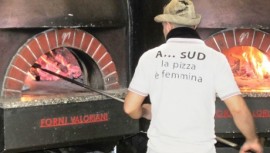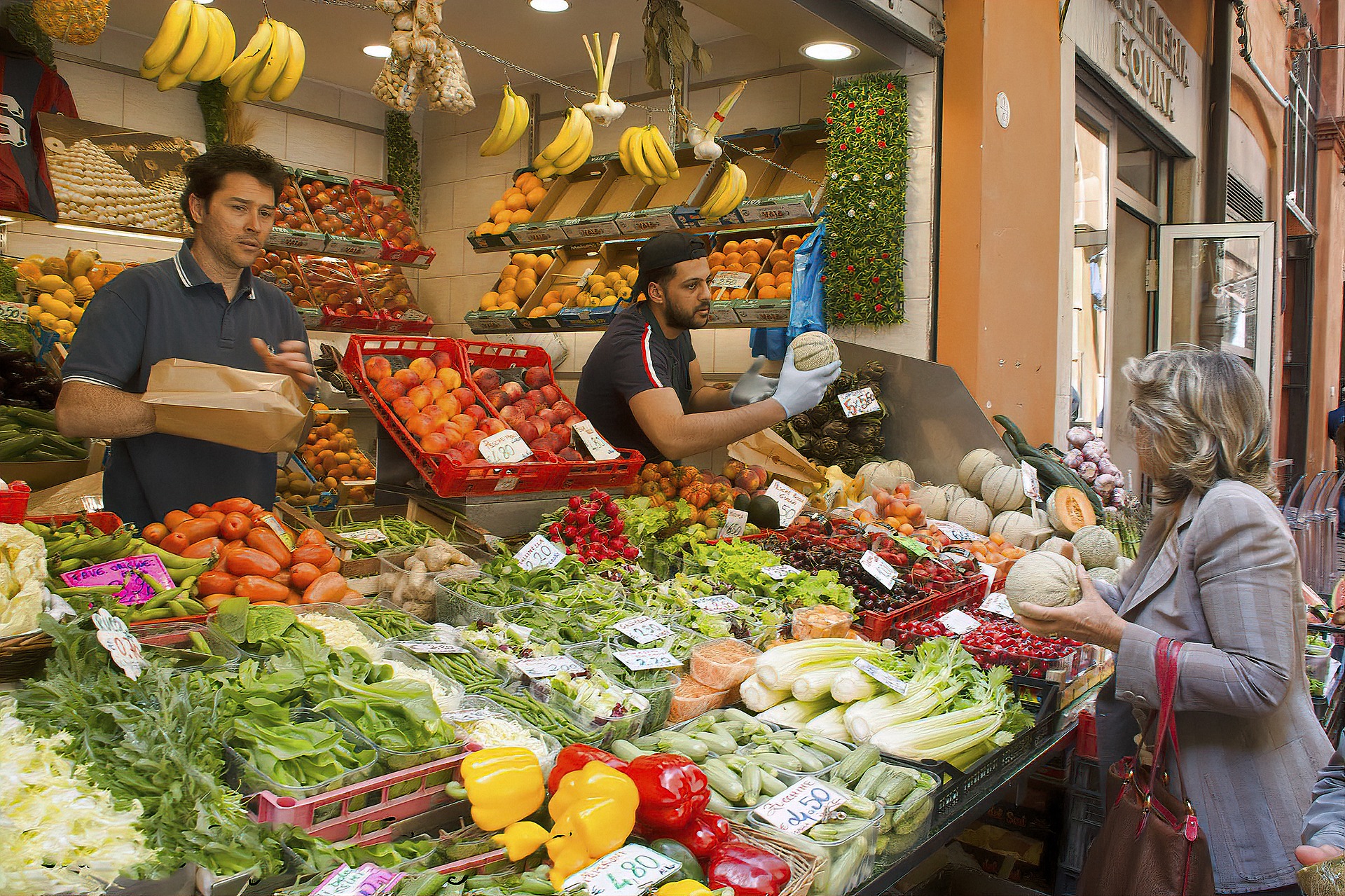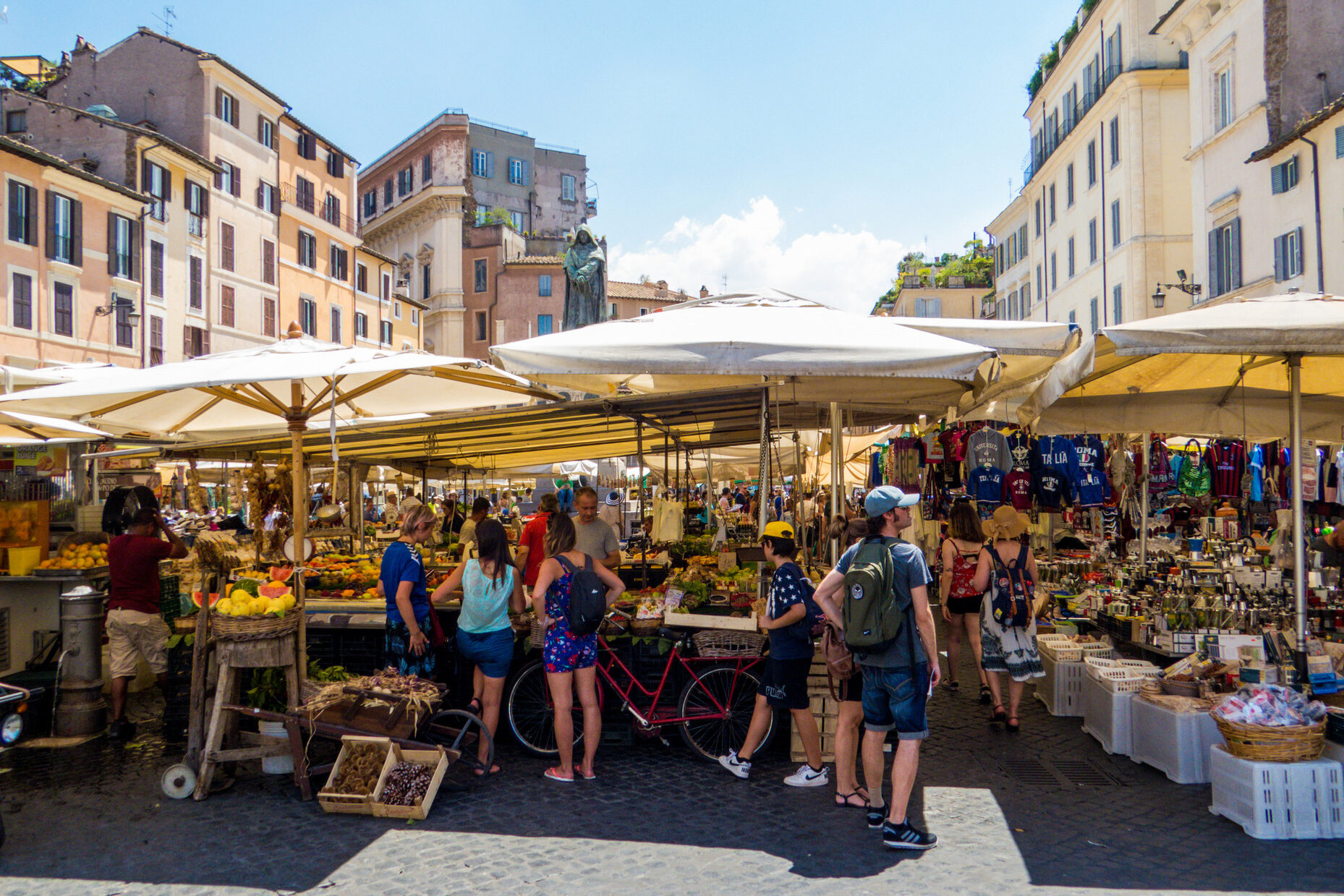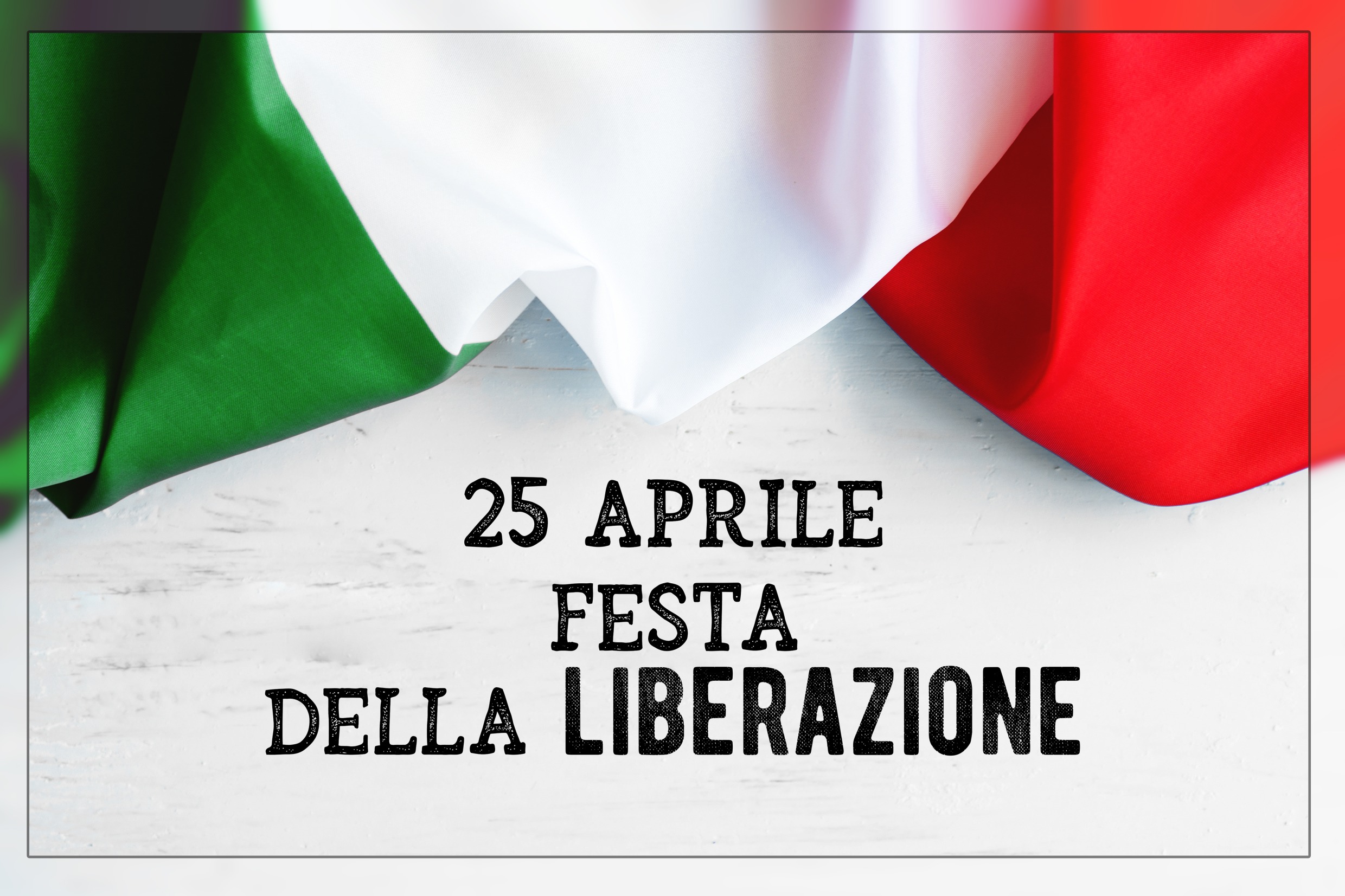Many years ago the famous British writer Elizabeth Bowen announced to her friends that she intended to write a travel book on Rome. They warned her that better writers than she had tried to write about Italy and failed. To write about Italy, or paint images of the Italian landscape is to enter into an historically conflicted zone where the real is constantly at odds with the ideal.
This conflict has a storied history in Italy. In January, my wife, Carole, and I visited a show, The Baroque Underworld: Vice and Destitution in Rome, at the Villa Medici. Over fifty Baroque-era painting, drawings, and engravings depicted the darker side of the otherwise idealized Eternal City.
In many paintings, murders, thieves, and prostitutes, often engaged in lascivious, drunken bacchanalias, are depicted among Rome’s classical ruins. The Baroque painters consciously placed the “darker side of Rome” in a landscape that Renaissance painters had used to symbolize Italy’s idealized past. These same Roman ruins would become iconic images of an idealized Italian countryside in nineteenth century paintings, both European and American.
Today, any challenge to the otherwise romanticized image of the Italian landscape is sure to bring controversy with it, that same clash between writers depicting a constructed, idealized Italy with those who are more deeply in touch with Italian culture and society.

Last year I wrote about a controversial subject, one that has Italians, in and outside Italy, including tourists, irreconcilably divided: the new large-scale food courts that are springing up throughout Italy. I wrote about Rome’s recently opened Eataly in the abandoned train station Ostiense, now one of many throughout not just Italy but the world. I could hear in my mind’s eye my critics’ disapproving glares and hear their arrogant muttering: “That’s not the real Italy.”
But “real Italy” it is, like it or not. In April of 2014 the comune of Florence opened a large-scale food court on the top floor of Florence’s central market, named appropriately Il Mercato Centrale di Firenze, only a few minutes’ walk from Eataly’s location on Via dei Martelli. Many see such large-scale food spaces markets as little more than a commercialization of Italy’s sacred culinary tradition: the small trattoria owned and operated by local families.
When I learned of Il Centrale, Carole and I had only arrived the day before from Rome with twenty students from the University of La Verne, our fourteenth tour of Rome and Florence during January term since 2000. By 10AM the next morning, Carole and I took our first small group on a short walk from the Hotel Globus to the Mercato Centrale. We toured the vegetable and meat market on the first floor, examining its array of food products, all in their own way an important window into Italian culture.
Before ascending the stairs to the second floor, I explained to our students that several years ago, the comune decided to improve the upstairs space where the vegetable vendors once had their stalls. The understanding was that the vendors would move, but only temporarily, to empty spaces on the first floor and others to a covered space in the parking lot.
However, when the remodel was completed, the word on the street was that they refused to move their stalls back upstairs. They were making more money downstairs where there was better customer access to their products. Acquiescing, the comune gave in, moved those in the parking lot into vacant stalls on the first floor and allowed the others to remain.

But the comune was faced with a big problem: what to do with the vacant second floor space? In its hulking silence above the very center of the town, the cavernous vacant space spoke volumes about Italy’s depressed economy and high unemployment rate.
At first, again according the word on the street, the comune considered putting in a disco. But discoes open around 10PM and close around 4AM. The foot traffic it would generate would be of no value to the surrounding businesses, including the San Lorenzo Market stalls.
Then according to word on the street again, Prime Minister and former mayor of Florence, as he is sometimes known, Matteo Renzi, asked help from an old friend, purportedly an Eataly executive. (I tried hard to verify this one, but Renzi was in Rome meeting with Merkel). The outcome was that the comune hired a firm, not Eataly, to remodel the space and put in a large food court, in the style of Eataly.
With Renzi behind the project, the filibustering Italian bureaucracy was silenced. In the era of austerity, the comune quickly found five million euro to develop the project. After little more than six months, by the end of April 2014, Il Mercato Centrale di Firenze opened. The once hollow space was transformed into a welcoming, inexpensive, and enjoyable place to eat, drink, and just hang out. Each day, its doors open at 10AM and do not close until 12 weekdays and 1AM on the weekend.
As one young Florentine said to me, this is just what the youth of Florence needed: an inexpensive place to hang out with friends. But judging from the crowds I surveyed in my many eating and late-night reconnaissance visits to Il Centrale, it is a space now enjoyed by all age groups, including large families that come early and commandeer tables for dinners that last hours. As one middle-aged shop owner said to me, Il Centrale is a nice addition to the city, because it is “new.”
Only a cynic, one hopelessly wedded to those idealize images of Italy, would not be impressed with Il Centrale’s spectacle of wine and beer bars, blazing pizza ovens, mozzarella bar, dessert counter, sandwich booths, fresh fish counter, and restaurants grilling bistecca alla fiorentina over wood fires.
Adding to the hip atmosphere, at one end is the Leonardo Da Vinci Culinary School with its glass wall that allows viewers to watch the making of the next generation of Italy’s chefs. Architecturally, the space is buttressed by giant, black I-beams tied together by steel cables. I was reminded of Turin’s and Rome’s Eataly: the spectacular and creative design of those older spaces by Italian architects. They are inspired reuses of once abandoned and presumed useless structures.
I must echo the opinion of those Florentines I spoke with and say that Italy has a right to be modern and progressive. The search for that “out of the way” trattoria has become another of the many clichés used to locate the “real” Italy. Carole and I have found that our favorite restaurants anywhere in Italy are often just a step away. In any country, you must know how to look, not just where.
During our weeks of preparation before we left for Italy, Carole and I spoke at length to our students about the regional nature of Italy’s cuisine and how important it was to an understanding of Italian culture to sample and savor local dishes in the various towns they would visit. Before we entered the first floor of Il Mercato, we stood outside and I explained that much of what they would find inside, among the meat, cheese, pastry, and bread stalls on the first floor, as well as those on the second floor, would reflect that commitment to local cuisine.
As part of our course, they needed to try everything. When ordering a panino in a café or dish in a restaurant that is unfamiliar, never ask “what’s in?” Just order it and eat it. Given American students’ fast food palates, I might be asking too much of them.
When we went upstairs to the new space, we passed first the cheese vendor where the proprietor makes mozzarella daily. After tasting the mozzarella at Il Centrale, there is no need to go to Naples. We also took special note of the prices of all the food and dishes, all priced reasonably. This is not for the crowd that hangs out at the Cantinetta Antinori located in the Piazza Antinori at the end of Via de’ Tornabuoni, but for families and the under thirty-five crowd on a budget.
At the mozzarella bar, large cheese plates, certainly for more than two people, range in price from 10 to 12 euro. We stopped before the two large wood-burning ovens at La Pizzaria, where the pizzas range in price from only 6 to 9.50 euro with less expensive pizza al taglio. In addition to the reasonable prices, there is no charge for table service: no two price menu, one standing and one sitting. In fact, servers will take your order and serve you without a service charge.
At La Pasta Fresca, the dishes range in price form only 4 to 9 euro, all made on site. La Birreria has a full range of artisan beers, all at a reasonable price. Il Ristorante Tosca has a full menu, priced competitively. For the evening meal, they have the third floor mezzanine, which affords a spectacular view of the entire second floor, including the large basket chandeliers that hang from the high ceiling. At Il Pesce Fresco, you can have fresh oysters or your fish and shrimp any size or number prepared to order.
At Marco Rosi e Paolo Soderi’s space you can have a plate of pollo or coniglio, including a side dish, for only 8 euro. It would be pointless to look for a less expensive dish elsewhere in town.
At Il Lampredotto, run by Lorenzo Nigro, you can have your sandwich with salsa verde, piccante, or peperoni for a mere 4 euro. For only 5 euro next door at Il Tramezzini, run by Fabrizio Bodini, you can get the town specialty, a porchetta sandwich with potatoes for only 5 euro.
But if you wish to blow your expense budget, at Il Tartufo where you can have pasta con tartufo, for 22 and 16 euro per plate for the seasonal white and black truffles. At the nearby wine bar, all wines are from Italy, and all wines are 5 euro a glass. All drinks, whether coffee or wine, are served in glass or porcelain. But in keeping with the laid-back atmosphere of the space, nearly all dishes are served on paper plates with plastic utensils. Every item is recycled.
The Leonardo Da Vinci Cooking School was in session the morning we were there. The students were hard at work preparing the filling for Sicilian cannoli, including instruction on how to make the shell. The next morning they were laboring over a written examination before they returned to their spaces to make a chocolate sauce.
On the weekends Il Centrale is crowded with lines at nearly every counter. But because we are in Florence in January, the customer base is largely Florentines. But this will certainly change during Italy’s high tourist season. Beyond the jobs that the five million euro created in the remodeling of the space, Il Centrale has generated over one-hundred and seventy permanent jobs. I took special note of the fact that nearly all the workers were under thirty-five, the hardest hit demographic section of the Italian economy. Currently, the 18-35 age group has a 35% unemployment rate. If they do find work, most young Italians, must accept short-term contract jobs at low pay and excessive number of hours per week.
Upon exiting into the Piazza Mercato, you see the Ganapathi Mini Market, the Macelleria Halhal, and the Alimentari arabo, africano, e asiatico. Just steps away from our hotel there are Chinese, kabab, and Japanese restaurants, including stores owned by recent immigrants.
This is modern Italy, the one that Il Centrale also represents. This is what idealizers complain about. But like it or not, Italy is modern society with modern issues, including immigration, that require changes. Certainly, Eataly will be visited by tourists. According to one web source, tourism in Italy generates more than 45 billion dollars a year. But it is an industry whose impact on the environment can be effectively controlled and minimized.
I would be a hypocrite if I did not admit that this spring Carole and I will return to Rome for an extended study of Italian in Rome. Thereafter, for about the fifth time we will again drive through Italy’s northern regions and visit churches and museums while sampling the local cuisine and drinking the local wine. Don’t misunderstand me, the old never gets old in Italy.































